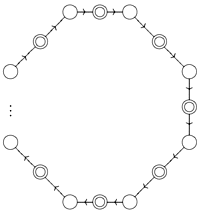
|
|
Deconstructing Dimensions
|
The Standard Model of particle physics is an incredible triumph for theoretical physics. Within a mathematically consistent framework, it explains all known subatomic interactions up to the energy scales of current particle accelerators. It provides excellent predictions about the composition of the universe immediately after the big bang. It even "predicted" the existence of the top quark in 1995.
But at best, the Standard Model is incomplete. Many of the parameters of the theory cannot be known a priori and must be extracted from experiment. There is no explanation for the particle content of the universe. The Higgs mechanism, which is invoked to explain the masses and interactions of the particles we see at low energy, is both the glue that holds the Standard Model together and a theoretical sore point.
Therefore, we strive to find extensions to the Standard Model that enrich the structure of the universe without contradicting the famously accurate correspondence between theory and experiment. We look for novel models and interesting symmetries not so much because we believe that we can pluck the correct theory out of thin air, but because we know that whatever happens at the next generation of particle accelerators has to be different than what we already have seen. We feel obligated to search the space of "all possible worlds" to find hints of what might explain this, our world.
In June, I presented an introduction to the supermultiplet formalism of Supersymmetry. Supersymmetry is an extended space-time symmetry that links bosons and fermions. Though we haven't yet observed the so-called superpartners of ordinary matter, we have not yet ruled out the possibility that at very high energies, these "sparticles" might emerge. Supermultiplets are merely a convienent way to group these fermion/boson pairs, and if we put every Standard Model particle into their own multiplets, we generate the Minimal Supersymmetric Standard Model. In July, I explored dimensional deconstruction. In deconstruction, a theory that is well-behaved and four dimensional at high energies becomes a model of a compact fifth dimension at low energies. This is to be contrasted with the usual view of extra dimensions where a theory which looks four dimensional at low energies "opens up" to extra dimensions at high energies. Deconstruction is based on the simple model building tool of Mooses, and in my talk I elaborated on the simple connection between so-called linear Mooses and deconstruction. An extension of dimensional deconstruction is gravitational deconstruction, where different gravitational spaces are linked together. In order to understand gravitational deconstruction, I wanted to first understand gravity as a field theory, so at the end of July, I gave a talk on the structure of gravitational theories. In particular, we saw that Einstein's theory of gravitation is (almost) the unique consistent theory of a spin-2 particle. Also, we saw that something very strange happens when you try to make gravity massive. In August, I worked with Can Kilic to understand gravitational deconstruction and the structure of theories of massive gravity. The key paper we analyzed was by N. Arkani-Hamed, H. Georgi, and M. Schwartz. "Effective Field Theory for Massive Gravitons and Gravity in Theory Space." hep-th/0210184.
For information about this reading course, including a list of scheduled talks, click here. I hope to continue my study of Beyond the Standard Model physics in the Fall.

|
|
Forming a BTZ Black Hole
|
In particular, we found no exponential supression or enhancement of the process. This is different then the result predicted by models that assume a test particle falling in an effective black hole background. We believe the reason for the difference is that the total energy of the system is the mass of the created black hole, so models that assume a small mass test particle ignore the fact that the test mass kinetic energy must contribute to the mass of the black hole. This changes the diverege of the momentum near the effective horizon from a linear to a logarthymic diverges, so the classical action is finite as opposed to infinite, therefore the semi-classical transition amplitude does not have an exponential factor.
I published a paper with Antal Jevicki in Physical Review D in the Spring of 2002. Phys. Rev. D66 024041 (2002) To see an arXiv pre-print, go to article hep-th/0203172. I was an APS Apker Award finalist for this research. For more information about black holes, you can view PDF versions of three documents I prepared for my senior thesis:
For most of the summer, I learned about the fundamentals of Group Theory and Lie Alegbra. I gave three presentations as part of my study: the first covered classical and quantum mechanics on the SU(2) symmetry group; the second covered the characters and representations of SU(N) with a followup presentation on the equivalence between the characters of a group and the eigenstates of the group Hamiltonian; and the third covered the relationship between Matrix Models and Integrable Systems (i.e. systems with a conserved quantity for each degree of freedom). The following lecture notes are available in PDF format:
Then, I studied the relationship between Matrix Models and Supersymmetry. Roughly speaking, supersymmetric systems are systems that are invariant under an exchange of bosons (force carriers) and fermions (matter particles). The structure of supersymmetric systems is closely connected to a study of Clifford Algebras, and these algebras impose limits on the kinds of systems that can exhibit supersymmetry. You can view a PDF version of an abstract and summary from an undergraduate research symposium and poster session hosted by Brown University:

|
|
Energy Minimizing Configuration for Twenty-Five Points
|
This mapping was based on a geometric energy function, and we hoped that it might lead to insight about minimal energy configurations of interacting (or non-interacting) particles. In fact, the energy function looked very similar to the determinant of a (lattice) string action matrix, so there was a glimmer of hope that the Atiyah/Sutcliffe paper might have relevance to String Theory. (String action is minimized by constant curvature surfaces, and the Atiyah/Sutcliffe energy minimizing configurations were approximately spheres, examples of surfaces with constant (positive) curvature.)
Unfortunately, we showed that the only possible connection could occur for an infinite lattice and not for a finite lattice. For a finite lattice, the string action matrix was singular (i.e. zero determinant), and only for an infinite lattice could we get non-singular matrices. Because an infinite lattice is impossible to model on a computer, and because the Atiyah/Sutcliffe configurations involved less than 30 points, we concluded that there was not a strong enough connection to warrant further investigation.
As a side note, the Atiyah/Sutcliffe paper was inspired by an earlier paper published by physicists M. V. Berry and J. M. Robbins entitled “Indistinguishability for Quantum Particles” (1997). They offered a possible explanation for the connection between spin and boson/fermion properties within the context of non-relativistic quantum mechanics.
For an accessable look at String Theory, check out The "Official" String Theory Web Site.Investigations in String Theory, Supersymmetry, and Black Holes
String Theory is presently recognized as a leading candidate for unification of all basic interactions in physics, including Gravity. A major ongoing activity in Theoretical Physics concentrates on an in-depth study of the theory (now called M-theory) with a particular emphasis on its implications on the physics of Black Holes and Quantum Gravity.
Detailed investigations hold the answer for some of the most challenging problems of physics and the origin of the Universe. The research problems addressed by Prof. Jevicki and his collaborators directly relate to these ongoing studies. One of the fundamental issues concerns the nature and possible modifications of Gravity that emerges from String Theory. Specifically, an interesting conjecture put forward by Prof. Jevicki and Prof. Ramgoolam (Brown) would imply that space-time itself is non-commutative. [see: A. Jevicki and T. Yoneya, "Space-time Uncertainty Principle in D-particle Dynamics" (hep-th/9805069) and A. Jevicki and S. Ramgoolam, "Non-commutative geometry from the AdS/CFT correspondence" (hep-th/9902059)]
Under the first part of an UTRA project, Jesse would be involved in further study of the non-commutativity conjecture, its origin and implications. Most interesting implications which would be addressed in the second stage of this project concern the physics of Black Holes. There has been a long-standing issue of reconciling Black Holes with Quantum Mechanics, a problem that can now be addressed by String Theory. In particular, the theory with a help of a newly discovered (Super)symmetry allows for counting of states entering into a formation of Black Holes. An explicit construction of exact quantum states describing Black Holes is then of major significance, it would be considered at the second stage of the present UTRA project.

